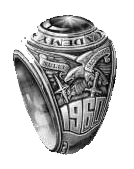
Messages of General Interest--2017
As folks send email to change or add addresses and phone numbers, they often add a tidbit of information that may be of interest to everyone. Accordingly, these messages have been placed in Shared Messages. You are encouraged to post any anecdote or input that will let your classmates know what's going on or how and what you're doing. All gossip and news of general interest will be accepted. All jokes and puns will be measured against a higher standard.
Send your message to share HERE .
.
USAFA CLASS OF 1960
RENO MINI-REUNION 2017
(See the photos HERE.)
And so, the close of the Mini-Reunion of the Class of 1960 came to a very successful end in Reno, Nevada. This reunion was held in the same month, June, as we graduated from the Academy 57 years ago.
I want to thank everyone who chipped in their time, talents and money to make this reunion extremely successful!
Class members and wives, who attended, in alphabetical order, were:
- Boyington, Gregg
- Kerr, Jim & Erika
- Delisanti, Nels
- Swainston, Harry & Annette
- Diver, Charlie & Edie
- Thompson, Charlie & Mercedes
- Doyle, Dick & Donna
- Valerie, Paul & Kay
- Furuta, Ben
- Whitfield, Howie & Jutta
- Head, RG & Carole
- Yoakum, Vic & Suzanne
- Johnson, Deke
- Zersen, Bill & Doris (Sister)
- Kaspar, Miles & Charlotte
- Zimmerman, Alex & Pam
At the last moment Ken & Carol Biele and Dave & Marilyn Luce had to cancel because of medical reasons.
Several others thought that they might come but had to drop off the list before the final arrangements were made.
Most of the Classmates stayed at the Peppermill Resort and Casino in South Reno. A block of rooms had been negotiated so we had very favorable room rates. The Peppermill was really big. Probably took 30 minutes plus (45?) just to walk around the inside to see everything. Many restaurants and their food was GREAT!
The reunion started on 6 June on the second floor (away from the noise of the casino) in the Terrace Lounge (Tuscany bar- is my memory fading?). We had 28 people in attendance so we took over about 1/6 of the room--big, round bar with seating and tables all around it. Charlie Diver brought along and put up the “NORTHWEST FALCONS” banner that is used when the NW Falcons get to together somewhere around Seattle every month for lunch. We deemed this appropriate since the Northwest Falcons planned this event over a year ago.
Ben Furuta was kind enough to make nametags for all of us to hang around our necks--I really had no idea as to who some of our classmates were, so I really needed to see the name tags. The classmates name tags had their picture on them taken from the 1960 year book. Ben also volunteered to do the picture taking during the reunion--he did a superb job! Check out the pictures that were sent to all attendees separately--try to guess who was who!!!!!!!!
Not just to mention that the hors d’oeuvres were great, but they were also cost effective--we gathered there from 5--8(?) which was Happy Hour (4-7) in the Casino. I gave up around 8 PM and I have no idea who was the last man standing--it wasn’t me!
On June 7th, different people gathered to eat at various places in Reno for breakfast and lunch and to see the sights of Reno. I bumped into Alex and Pam Zimmerman at the “Black Bear Diner” for breakfast and joined them. I personally went to the Auto Museum as did a number of others. It was spoken of as being one of the top 5 auto museums in the U.S. Very large! I was impressed with the mint conditioned DeLorean and the Tucker cars.
Then at 5 PM we began to gather at “ZOZO’s Restauranté”. This restaurant (Italian) had a separate room which accommodated our group--we actually could have squeezed in some 36 people. Cocktails and stories flowed for two hours as we gathered. We had a separate table to put on our momentos that a number of people brought. Items included: 1960 and 2010 year books, and a “Contrails” (a book I didn’t like very much as a “doolie”) and info about the book that RG Head had written.
At 7 PM, we started our program with the Pledge of Allegiance. Harry Swainston was kind enough to bring a normal sized flag as the restaurant only had a very small one. Miles Kaspar led us in the pledge.
Jim Kerr then took the stage to lead us in a prayer. I had not seen Jim for 57 years--he was the one who knocked me out in our freshman boxing class. I almost didn’t get to fly because of that incident. His prayer for the Class ended up with the Lord’s Prayer which we all joined in with him.
After the waitresses served the salads we began our toasts and open comments. Charlie Diver had a number of words for the classmates (by name) who had gone before us to their final destination. All of our hearts were touched by his toast.
Another toast which was a surprise to us was by Ben Furuta. If you really think back, in 1956, it was only 10-11 years after the end of the internment of the Japanese in WWII. Ben’s family had been interned. But, my looking back, I don’t believe that there was anybody in our class who ever thought that Ben was different from the rest of us--it was a non-issue for us. Ben was very thankful that he was never singled out at the Academy.
For dinner we had one of three choices. I had sent the total restaurant menu out to all the classmates West of the Rockies to vote on what they wanted for dinner. The restaurant asked us to settle on three choices which ended up Prime Rib, Pork Tenderloin and Chicken Piccata. I have only one thing to say about the “GREAT” dinner. Gregg Boyington, sitting across from me had the biggest slab of Prime Rib I have ever seen--I don’t know how he was able to eat it all!
During dessert the floor was open to all comments. R.G. Head talked about (actually earlier during the toast time since we also were open to comments at that time) that it would be great to get together again in 2018 in San Diego. Perhaps we could call it something like “The Class of 1960 Mini-Reunion with the Birthday Party for All of Us Who Are Turning 80!” Make the mini a Class Birthday Party! Obviously this is way too long, but I will leave it up to RG to come up with whatever he wants to call it. But start planning for next year and as soon as we get some info from RG put it on your calendar.
And, obviously, this event would be open to the whole Class--even East of the Rockies, just like the Reno mini was open to all.
After the comments, I brought out two gifts (prizes). I first asked who was the oldest classmate there (Gregg Boyington) and who was the youngest classmate there (Ben Furuta). I then asked everyone to vote, which included all the women, as to which one of these should get the prize? By a vote of 15-13, Ben won the prize which was a bobble headed very old person standing in a large sack like one would see in a sack race. It was about 6 inches high. The words on the statue said “Old but Still Great in the Sack!”
For the door prize, all of the grads had dropped their folded up name in a large glass bowl. I had a waitress pick out two names for me. The prize for each one of them was a 25th Anniversary Wine Glass that had the Class of 60 Crest on it. I used two of my glasses as I had purchased a dozen of the glasses and I can’t remember ever using more than 5 or 6 of the glasses at a time over the past 30+ years. Might as well spread them around a little bit. Nels Delisanti and RG Head each won one of the glasses. I cautioned each one to not put the glasses in the dishwasher so the crests won’t disappear!
After the door prizes, Charlie Thompson took the lead and we all sang the Marines Hymn (for our Marine brethren) and the Air Force song with much gusto! I wonder what the people thought in the other room of the restaurant?
All business being over and since I did not have a gavel to close the reunion, I had everyone having a Class ring to begin a ring knocking ceremony!
We look forward to see what RG can put together for another mini-reunion next year. At last count there were (are?) 45 grads that live West of the Rockies. 16 made it to the Reno reunion. I wonder how many may make it to the next reunion!
Cheers until the Next Time,
Bill Zersen
May 17 2017
The new USAFA Commandant of Cadets
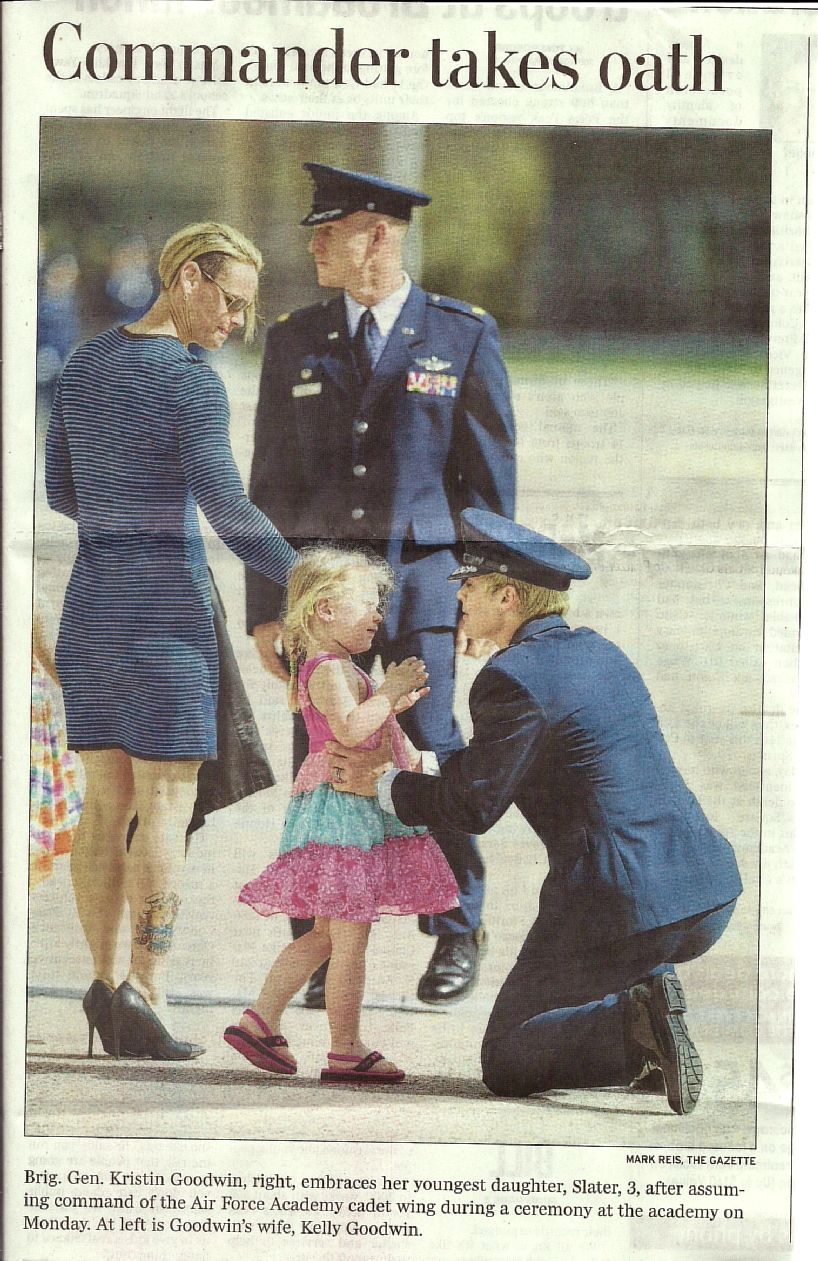
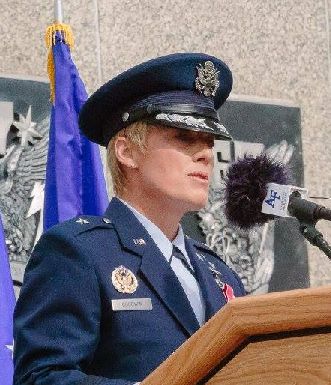
Read the Story here.

[Webmaster comment: What if one of the candidates for Commandant had been a male who had a husband or a male wife? He most likely would not have been considered for final selection for this "role-model" position? For now, there seems to be a difference in attitude toward gender? Who's determining what's O.K. or not O.K.? What will be the long-term effects of this selection on the Cadet Wing and the Air Force Academy? Comment to Webmaster ?]
April 4 2017
USAFA - THEN AND NOW
My wife and I attended the Inauguration of President Trump on January 20, exactly sixty years to the day that our class marched erect, proudly and in cadence every step down Pennsylvania Avenue to pay tribute to President Eisenhower at his Inaugural. After the swearing-in, my wife and I returned to our hotel room to watch the parade. When the USAFA cadets came into view approaching the reviewing stand, I expected to see the same formation with the same precision as we displayed in 1957. Instead, what I observed was a squadron of cadets with crooked rows and columns, many out of step and some with heads down, just the opposite of our class formation. These cadets did not appear proud, were not erect, and lacked precision. They marched in stark contrast to the cadets and midshipmen of USMA and USNA who made their academies proud. This display made me angry, not proud.
Then, I began to think that if this was the way the USAFA leadership prepared our cadets for the inauguration parade, what else is falling through the cracks in cadet development in Colorado Springs? I thought of many areas in which I perceived significant difference between the education and training of our class and current classes, some positive and some negative. I will cover the positives first, then dwell longer on the negatives that can be corrected over time.
I come at this not only with our own experiences from 1956 -1960, but also uniquely with the experiences of my son, USAFA Class of 1984, now a USAF major general, and grandson, Class of 2016, now a student in USAF pilot training. My contrasts come mainly from my grandson’s and his classmates’ experiences because they reflect those of the current generation of cadets and the current culture of USAFA.
First, some positives. Basic Cadet Training, particularly the time in Jack’s Valley, is tougher than we experienced. The number and quality of academic majors is larger and better. The academic faculty is stronger. Ratings for quality of education reflected by nationally recognized rating organizations are near the top in many categories.
The annual National Character and Leadership Symposium is in the big leagues, recognized as the best forum of its kind nationally and getting better every year. The research in drone and space technology and cyber warfare conducted by cadets and faculty at USAFA is the best in the country.
Cadets have a spirit of volunteerism. Their response to the Waldo Canyon fires in the summer of 2012 is one classic example. There are many more.
The cadet Wings of Blue and powered flight teams garner top honors every year. Our intercollegiate athletic teams compete favorably in all sports against top teams in the nation. Cadets have competed well in Olympic games and international competitions representing the USA.
The AOG has been the leader in keeping USAFA heritage alive with many memorials and legacy projects such as the Heritage Trail, the SEA Memorial, the Memorial Pavilion, the Wall of Heroes, and many more reminders of our air combat heritage.
Also, the proof is in the pudding. USAFA has produced a continuous long blue line of leaders, warriors and heroes, some of whom have served in the highest military and civilian positions in the nation and industry. So, USAFA has had a lot going for it yesterday and today.
But, nearly all of these are external manifestations of the Academy’s success. What concerns me more is the seeming erosion of internal, cultural attributes in the life of the cadet wing, which jeopardizes this tradition of success.
I recall many discussions with my grandson and his classmates about fundamental differences between their generation, the millennial generation, and our generation, the post-WWII generation, with respect to the USAFA experience. Those discussions and the TV images in my hotel room of the squadron of cadets marching in near-disarray at the Inaugural Parade have spurred me to write this essay.
I will confine my discussion to three problems with today’s USAFA; diminished air-warrior culture, unreasonable constraints on the free exercise of religion, and the de-emphasis of military discipline and culture.
DIMINISHED AIR-WARRIOR CULTURE
The USAFA of the late fifties was steeped in the air-warrior spirit to the extent that “air-warrior culture” became its best descriptor. Every aspect of academy life, for cadets, staff and faculty had a direct connection with the combat, or combat-related mission of the Air Force. We studied air campaigns, watched movies of air battles, studied the lives of past air leaders, walked and talked airpower constantly. Everything we did: in the squadron area, in the classroom, in athletics, in military training had a relationship to the warrior spirit. The air-warrior spirit was part of our DNA. It was on display every day.
Today, less emphasis is placed on this aspect of cadet development. In our day, the air-warrior spirit was alive 24/7. Today, this spirit is alive from time to time, but not embedded in every cadet’s psyche every day. One prevalent attitude is that cadets come to USAFA to pursue many different career fields, not just those directly connected to the air and space combat missions. The leadership seems to consider every career field equally important to the Air Force mission. But, that’s not why military academies exist. USAFA exists to produce officers of character to fight and win our nation’s wars. At least that’s my definition. Today, I observe that all career fields are judged to have equal priority, not just the operational ones. This attitude diminishes the air-warrior culture that marked our years as cadets.
One big reason may be the lack of Air Force officers with operational and combat experience in the commandant’s shop (AOC’s in particular), and on the faculty. This situation contrasts sharply from West Point where all tactical officers (AOC counterparts) and many faculty have recent combat experience. I blame this situation as a major contributor to the reduced air-warrior spirit and psyche at USAFA.
In fact, I have been told by more than one recent grad that some faculty members discourage cadets from going to pilot training because it imposes a ten year commitment that would inhibit cadets from pursuing other interests only remotely connected to the combat mission.
UNREASONABLE CONSTRAINTS ON THE FREE EXERCISE OF RELIGION
When we were cadets chapel was mandatory. Today, chapel is not only voluntary, with which I totally agree, but not emphasized as a component of character development. A fundamental shift in policy and importance of the religious and faith-based aspects of cadet life has occurred, to the detriment of cadet development in my opinion. My perspective on this comes from talking to both cadets and chaplains at USAFA recently.
Why was attendance at chapel an important part of our development? Well, in my opinion, our nation’s political and military leaders recognized a nexus between moral values, based on religious virtues, and military officer values. Chapel was a strong part of our character building. There was little opposition back then because most Americans recognized the strong correlation between faith-based values and officership. They went hand-in-hand.
Not anymore. The secular progressives in our society combined with a small cluster of anti-religious organizations have convinced the Air Force and USAFA that the rule should be ‘Freedom from Religion” not “Free Exercise of Religion” - the exact words in the constitution. The result is an attitude among USAFA leaders that any expression of faith outside the chapel or a cadet’s room may violate the First amendment. And, that is having a deleterious effect on the cadet wing.
The classic example (but only one of many) was the widely publicized case of the cadet who was forced to remove a short, biblical phrase from his whiteboard just outside his room that helped motivate him, on the preposterous notion that this violated the Constitution. But, this case is insightful because it caused an even further fear in the cadet wing that any expression of religion in the wing is verboten. It has had a ripple effect.
Sadly, USAFA leadership has opted for the easy way out, caving in to the anti-religious groups hell-bent on destroying religious expression in the cadet wing. That is bad for the development of character essential for leadership in today’s Air Force. The pendulum needs to start back the other way.
DE-EMPHASIS OF MILITARY DISCIPLINE AND CULTURE
From my talks with recent grads and through personal observation, I see a marked reduction in both the quality and quantity in military activities and military style. We stood for reveille in formation every day. We marched to every meal, breakfast, lunch and dinner. We marched to and from for every class during our Doolie year. We had SAMIs and parades every Saturday with the entire wing present. Intercollegiate athletes were not excused from SAMIs and parades. We ate at attention for virtually every meal our fourth-class year. Our Recognition Day was the first event of June Week, not in mid-March. We had few periods of leave during the academic year--none as fourth classmen. We had a strong sense of military discipline and customs drilled into us all four years. All these activities developed in us a sense of purpose, a sense of pride, and strengthened character formation. The training was constant, relentless and purposeful. <
Today, these military activities are greatly diminished. Yes, parades, SAMIs, in-ranks inspections, a demerit system still exist, but they are fewer and less intense than in our day. Parades are scheduled to coincide with major Academy events, such as Parent’s Weekend, Founder’s Day, Recognition Week, and a few others, but not every Saturday. Likewise for SAMIs and in-ranks inspections. The wing marches only to the noon meal, not every meal. Marching tours for gross violations or excessive demerits are rare. All meals in Mitchell Hall are taken “at ease” even during BCT.
A major change is the ease with which cadets, particularly “intercollegiate athletes”, can be excused from parades, SAMIs and other cadet activities. A squadron consists of about 100 cadets. Every parade I attended recently, had many fewer than 100 cadets marching, some with as few as 50-65. The remainder have been excused to practice or prepare for athletic competition, or some other reason. Of course, some excusals are warranted, but not that many.
Another observation is the amount of time away from USAFA granted to cadets. Fourth classmen no longer remain at USAFA all year. Upper classmen enjoy increasing time away year by year such that, by their first class year, they are only required to be in the cadet area for official duties.
My grandson and many of his classmates want the rigor and toughness of military regimentation. They don’t seek the easy way out. They would prefer tougher discipline, higher standards for achievement and increased opportunities for leadership.
Don’t get me wrong! I agree that some relaxation from the more extreme practices we experience is warranted. But, the pendulum has swung too far in the opposite direction. It is time to start moving it back, not to our level, but closer to it.
I conclude that this untoward de-emphasis of the military aspect of cadet life produces a weaker product at graduation. Military discipline and the activities that enforce it should be frequent, persistent and tough all four years. Today, they are not.
CONCLUSION
I have tried not to be overly critical. USAFA does produce officers with a basic grounding in honor, discipline and character. Most of today’s grads embody the best aspects of our Air Force and nation. But, too many opportunities are lost in their four years at USAFA, opportunities that would make them much better products with a deeper sense of purpose and motivation embedded with an indelible air-warrior culture.
The Air Force and USAFA leadership have acquiesced to the pressures of today’s society to accept constraints on discipline, religious expression, military training, even honor code situations. I understand the difference in political pressures and lawsuits prevalent today that we did not face. But, we need to stiffen their backbones to begin the march back to a USAFA more like one that we would recognize and our Nation expects.
Then, at the Inaugural Parade of 2021, we could see a cadet squadron looking sharp in every respect, and making us all proud. I look forward to it.
John Michael Loh
Class of 1960
March 12 2017
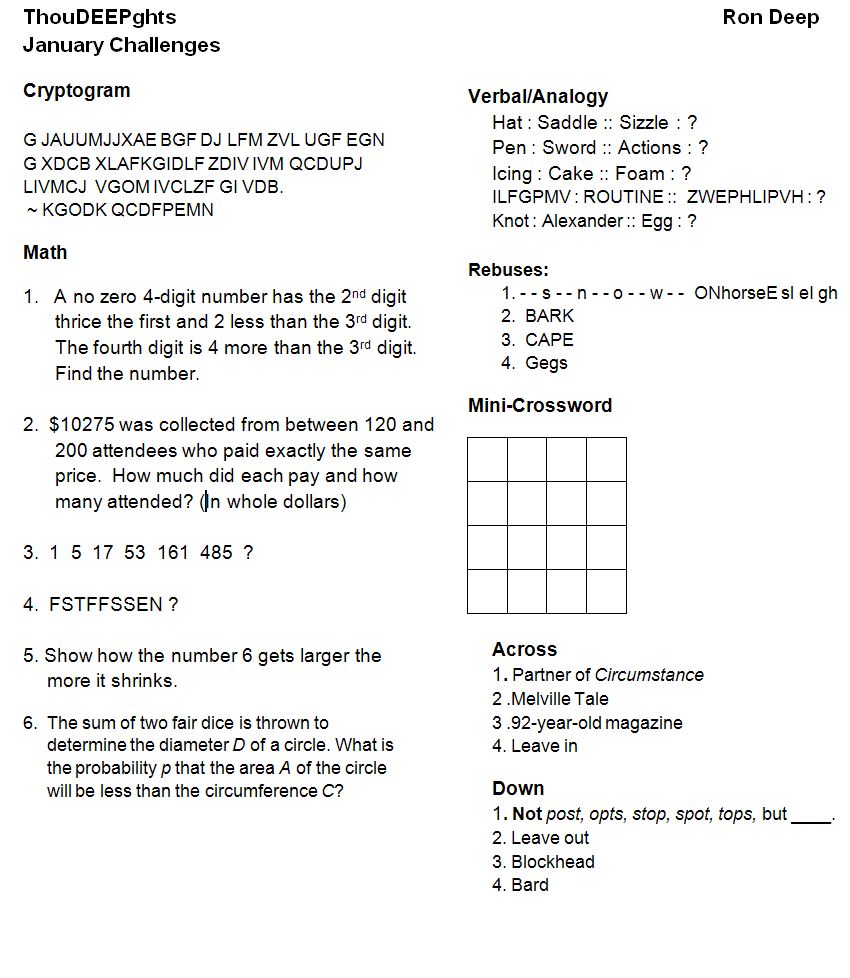
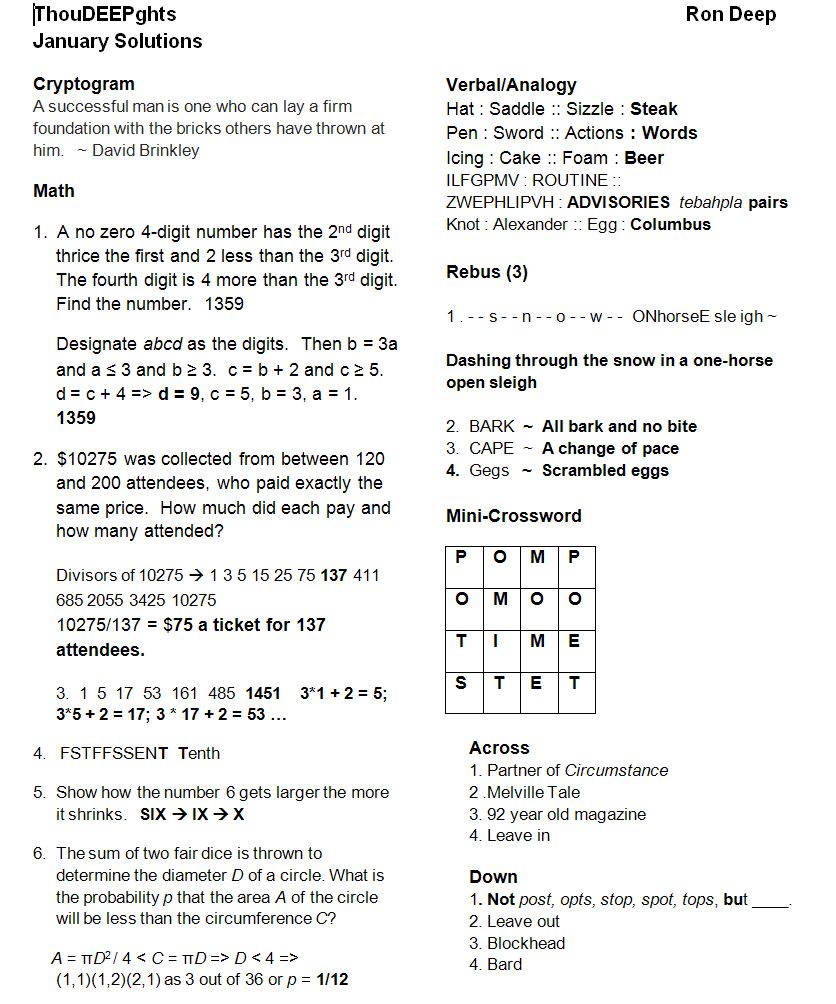
February 24 2017
_____________________________________________________
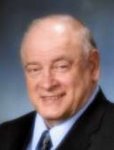
My Story by Ronald Giblin
About a year after I left you guys at Lowry, I joined the Army and, while doing Basic at Fort Carson, went up to visit Don Thurman and Tom Seebode. I told them that I was going into 'missiles,' and they announced that they were hoping to get into that field also. I don't think either of them ever did. Don wound up driving B-52s and did some work in Cambodia. Tom was a FAC pilot. I don't know for sure what he did back on this side of the Pacific except for some liaison work down South America way.
After Basic, I reported to Fort Bliss and did a 2-year school on Electronics/RADAR and the Nike Ajax surface-to-air missile system. I became a Fire Control Technician and an Instructor while there.
Next came an assignment to take a Battle–Field-Surveillance System to Germany. It was quite unique—sporting a Doppler-RADAR technique to pick up movement. Eventually, I transferred to a Redstone ballistic-missile unit at Neckarsulm in southern Bavaria. That assignment was most interesting. I was allowed to work on the inertial-guidance system. While I was with this Unit, MATS flew us all to White Sands for an actual firing.
It was never my intention to become a career soldier. To that end, I did study on my own for a civilian occupation (Industrial Electronics). It worked out well for me. On returning to the States in early 1961, I 'fell into' a job with the Monsanto Corporation in Alvin, Texas. They were building a new petrochemical refinery near there and needed about 30 (or so) guys with military electronics experience to maintain it. Again, very interesting stuff (Industrial Instrumentation). I worked for them for about 15 years in Texas and in Cincinnati. The Cincinnati time included some back-to-school effort at the University of Cincinnati Evening College, where I repeated every bit of math I ever had (math was my weak point while at Lowry) and went on to include Calculus. I was fortunate that my daily line of work and the years in industry gave me an ideal base to use while doing the school work, and I made good grades.
In those days (mid-70s), the industrial-control field was short of Engineers. I switched from doing the in-plant work to joining a local engineering-design/consulting firm. I stayed with the engineering phase of the work for the next approximately 30 years—ending up in this little town [Monroeville, AL] doing paper-mill instrumentation.
Now I 'play' on the internet, work crossword puzzles, do shopping errands, and keep a low profile.
Ron's contact information is in the USAFA '60 Members-Only Section.
[Webmaster's note: the Members-Only Section is no longer available]
January 30 2017
From Les Querry to the Class of 1960:
Shame in Washington
Last week, photos became available showing the USAFA cadets marching in the 2017 Inauguration Parade. The images were so appalling that I placed them on our Class website and sent them to George Lester for his blog. Having gathered more images, I'm doing a final vent to the Class.
I am thoroughly disgusted at the photos of the cadets at this year's parade. Check out those "straight" columns. And this was during the "eyes left" pass in review for the president, with the whole world watching.
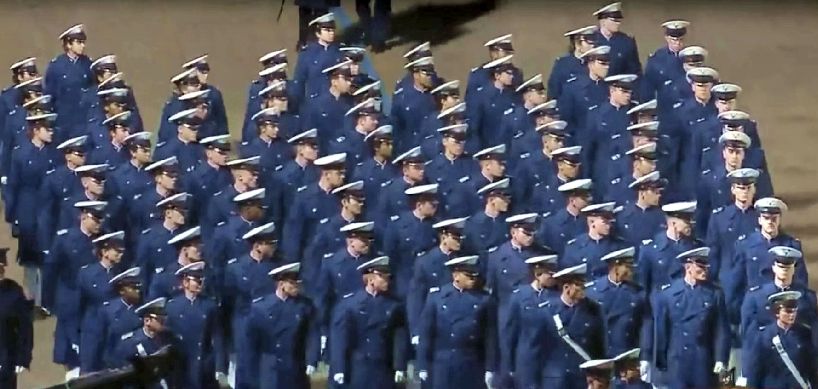
In 1957, we and the ATOs applied ourselves selflessly to provide the country with a worthy first impression of the new Air Force Academy.
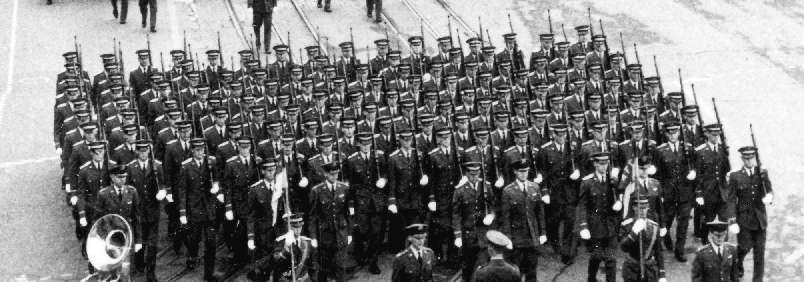
Now in 2017:Sloppy; some 180 out-of-step, some heads up, some down, some eyes up, some down, some caps high, some low. All appear to be unique individuals on parade. Along with the cadet up front, the three cadets shown in the back are also 180 out of step. Can you imagine what this college-kid gaggle must have looked like in motion? Check the variation of the position of the individual feet. You could have gotten seasick looking at them.
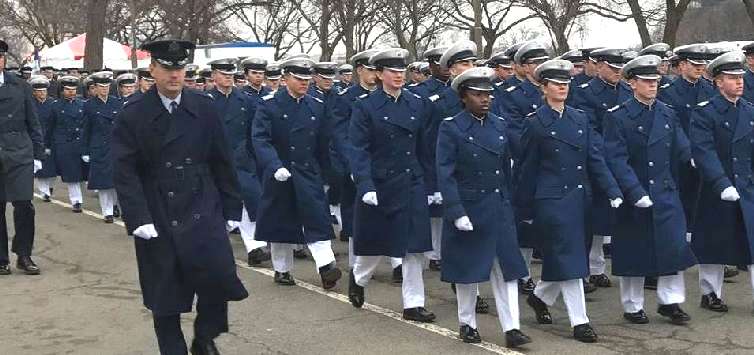
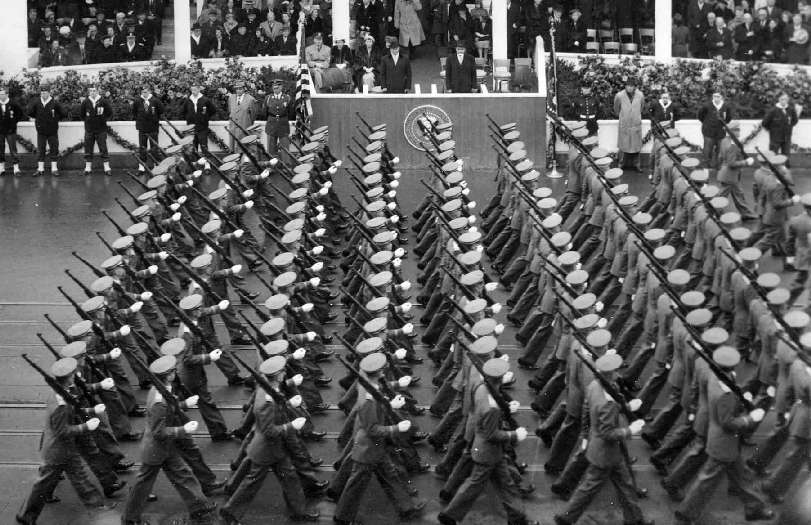
Read General Twining's message to USAFA in 1957:
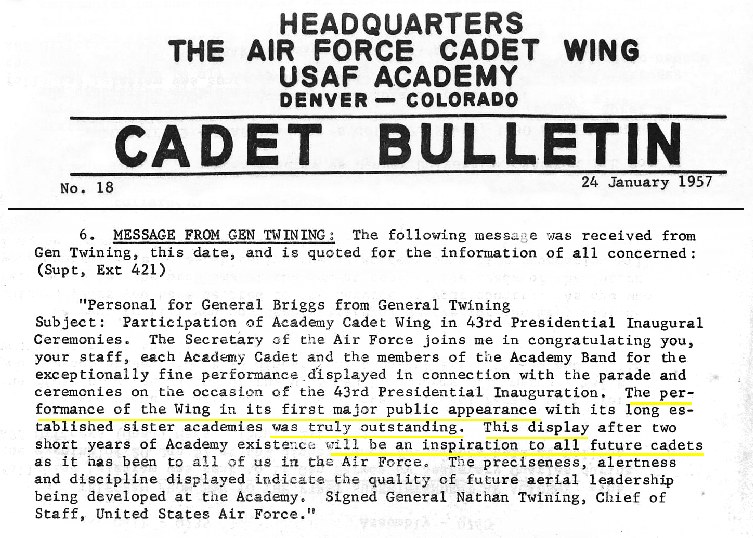
Too bad that his statement "This display.. will be an inspiration to all future cadets . . . " did not come true. He forgot to add " . . . and their leaders."
Some might say that it isn't important today for cadets to march with any precision. That's for drill teams and marching bands. But these cadets are supposedly being trained to be able to perform in well-synchronized military operations that will require timely individual contributions with no room for individuality. They need to realize that each of them is individually contributing to an operation that is larger than themselves. When else in their daily routines do they get the experience of operating in unison?
The photos do show a lot more than cadets trying to march together. They also seem to show them operating in a strange environment, that of coordinating with others in which they depend on others and others depend on them (not unlike daily life in the Air Force. huh?). I've witnessed the same "individuality" attitude even back in 1995 when lunching with the cadets in the dining hall (something that I've resolved to never do again). The total lack of decorum was annoyingly obvious.
I actually do not fault the cadets and am very sorry that they may receive the brunt of the criticism and embarrassment for this unfortunate display. It is the failure of the personnel that are
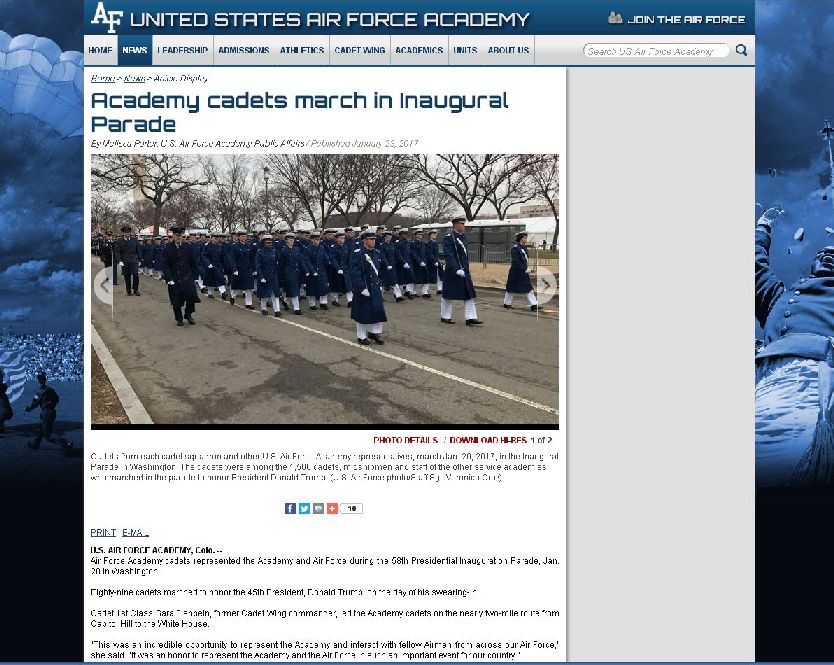
This is the Gaggle practicing for the parade, a lot different than at 5:00 AM on a cold, dark parade ground at Lowry in 1957:
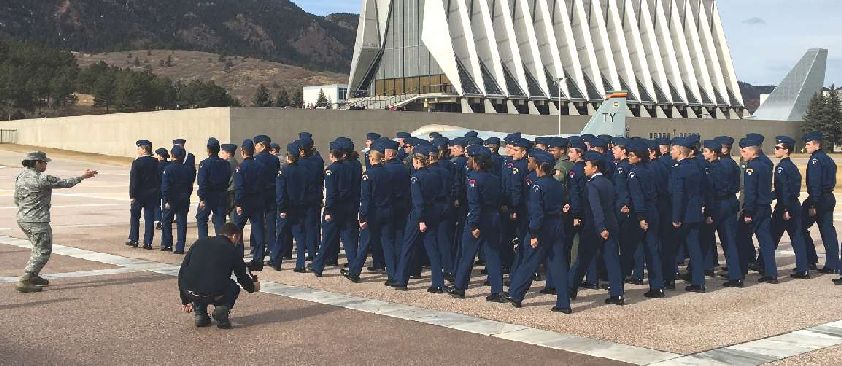
If USAFA intends to continue the practice of marching, they need to revise the last phrase of their motto, maybe add "except marching". Some have said, "They should just put back the old sign".
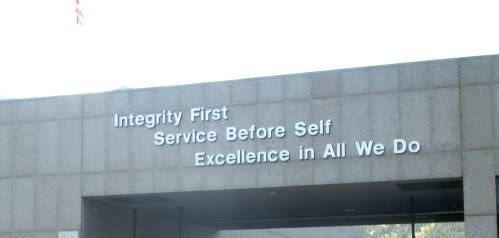
January 26 2017
From Andi Biancur:
The Falcon and the Tiger
As legend clearly states, the falcon mascot was selected by popular vote of the Academy's Class of 1959, the first class to graduate from the Academy.
Reading the words describing the USAFA mascot on the “Official Site of Air Force Athletics,” one would not see anything remarkable about the origin of the Falcon as its mascot. Clearly the account of the process is perfectly logical and reasonable. In short, the decision is noted thus:
“Members of the Class of l959, the first to enter the Academy, chose the falcon as the mascot of the cadet wing Sept. 25, l955, feeling that it best characterized the combat role of the U.S. Air Force. They did not specify any particular species, thus, any falcon can serve as mascot. Some of the characteristics which led to its selection were speed, powerful and graceful flight, courage, keen eyesight, alertness, regal carriage, and noble tradition. The falcon exemplified the qualities sought in Air Force Academy cadets: courage; intelligence; love of the wild sky; ferocity in attack, but gentleness in repose; and discipline."
. . . makes perfect sense
Of interest is really the story behind the story which brings into focus the little known facts leading up to the selection of the falcon and one important character aptly named “Quincy” who devolved from that selection.
In the early spring of 1955, the Commandant of Cadets, Brigadier General Robert M. Stillman appointed an ad hoc committee of assigned junior officers to recommend an appropriate Academy mascot.The committee, under the chair of Captain Harrison H. D. Heiberg, considered animals including the lion, bear, tiger, and such birds as the eagle and falcon. As the story goes, by June, the committee had narrowed the field to the tiger, as representative of the spirit of the American Volunteer Group--The Flying Tigers of World War II, and the falcon; but recommended the cadets be given the privilege to select the mascot as part of establishing their own tradition.
Over the summer months, the ongoing competition heated up as both the Class of 1959 and their acting upper-classmen--the Air Training Officers (ATOs) took sides and formed allegiances to either the falcon or the tiger.< And, by the start of September 1955, when the entire wing had completed their summer training and settled into residence at Lowry Air Force Base, the debate was in full swing. Both cadets and ATOs became involved in support of one of the two candidates.
Based on accounts of several of the members of the Class of ’59, the first vote, sometime around 15 September went overwhelmingly to the tiger. That decision was not accepted by those in command, stating the cadets were just not fully aware of the prowess. Skills, and character of the falcon.
Superintendent General Hubert Harmon contacted a local falconer, Dr. Harold M. Webster (USNA graduate) on 23 September with a request to conduct a falcon flight demonstration.
Following a very impressive live demonstration of the falcon, conducted with live prey on the Lowry Parade Ground on 24 September, the issue went to a fairly informal show of hands in the Cadet Dining Hall at the noon meal on 25 September, 1955. As recorded, the falcon gained the majority (almost unanimous) of votes from the class and was dully installed as the “Official” U.S. Air Force Academy mascot.
This is not the end, but only the beginning of the story.
It seems that ATO J. Quincy Collins, working on a Christmas project during the late autumn of 1955, acquired a stuffed tiger as a symbol of his work on Christmas for Kids in Denver. Upon completion of that project, Lt. Collins gifted the tiger to the Cadet Wing, where it wound up atop the grand piano in the ballroom, under the care of the Cadet Wing Hostess, Mrs. Gail McComas.
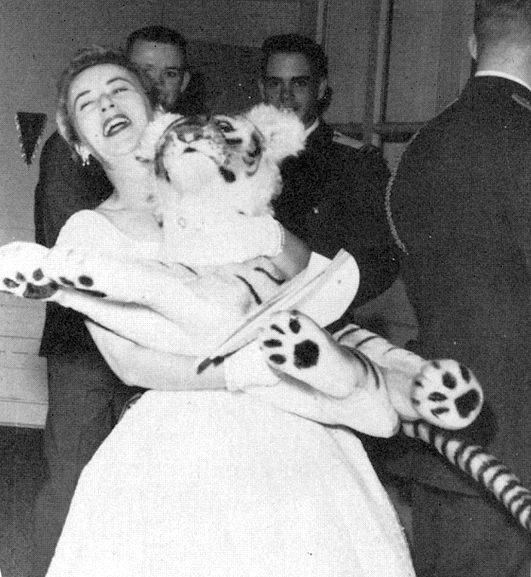 Mrs. Mac and Quincy--1956
Mrs. Mac and Quincy--1956 Sometime over the next two years, the tiger acquired the name, “Quincy.” and remained a fixture on the piano until the Academy departed Lowry AFB.
In September, 1958, Quincy moved to the permanent academy location with the wing and assumed his rightful position on the piano in the new Arnold Hall, where he remained for nearly 30 years.
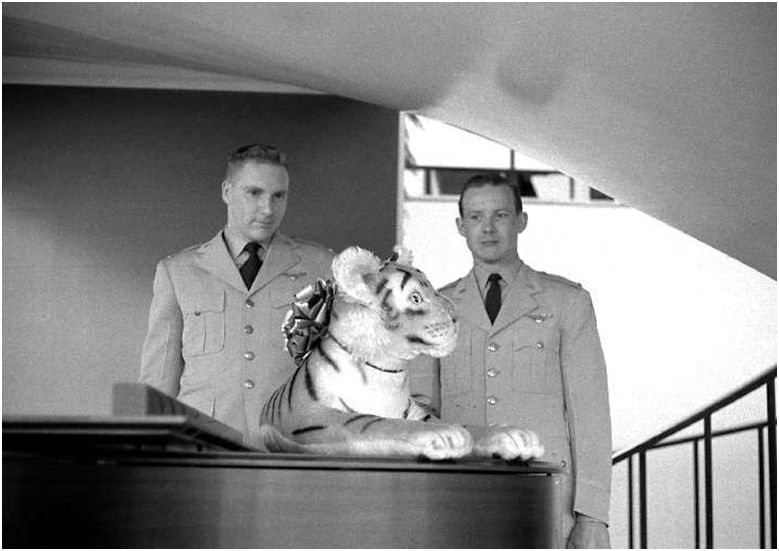 Lts. Jerry Till & Jake Jacobsen in Arnold Hall - 1959
Lts. Jerry Till & Jake Jacobsen in Arnold Hall - 1959 In 1959, the Class of 1960 paid honor to Quincy and his part in the early days of the Academy by making him a key part of their class ring ceremonies.< Small replicas of Quincy with a silver bracelet around his neck carrying their newly minted class crest were presented by each class member to his date at their formal ring dance in Arnold Hall.
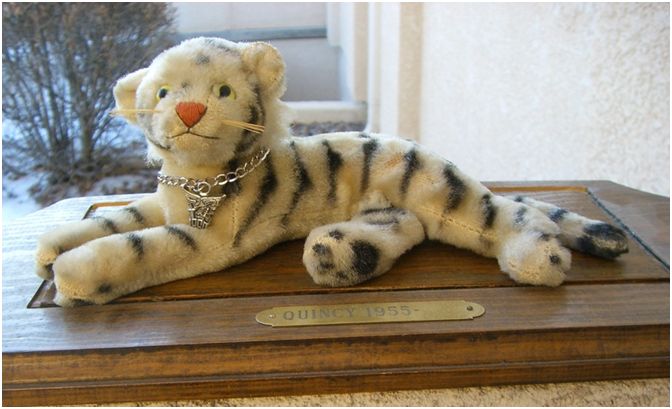 Class of ’60 Ring Dance favor - 1959
Class of ’60 Ring Dance favor - 1959 Prior to her eventual retirement as Cadet Wing Hostess in 1977, Mrs. Mac placed Quincy in the hands of a graduating senior for safe keeping.
He was not seen again until that graduate returned him when that graduate returned for a class reunion.Over the intervening years melding of the two stories as to Quincy’s life became blurred as most early graduates recall Quincy as the representative tiger of the mascot selection. (A mis-characterization recently clarified by Col. (Ret.) J. Quincy Collins.)
Since his return, Quincy resides in the Association of Graduates CEO’s office in Doolittle Hall. He remains on duty there as a very important visible reminder of a rich heritage and tradition which will forever End George Elsea writes: Subject: Selling house in Scotland Evelyn and I sold our house in Dingwall, Scotland, in summer 2016 after owning it for 19 years. Why did we buy it in the first place? Evey was born and lived in Inverness, the “Capitol of the Highlands”, about 15 miles from Dingwall. We were married in Inverness in 1965 while I was stationed at RAF Lakenheath, England. She stayed with her parents in Inverness during my two years in Southeast Asia. Our family visited Scotland many times during our two assignments in Germany and one in the Netherlands. During those times of staying with Evey’s family I enjoyed taking advantage of Scotland’s “Freedom to Roam” with family members and friends to go hiking and camping wherever the urge took us. I especially enjoyed pursuing wild trout in many of the 6000 lochs in the hills and mountains of the Highlands. We and our children made many friends and enjoyed life while we visited. Following my retirements from the Air Force and EDS we found ourselves living in Virginia thousands of miles from our children and parents It was any easy decision to take advantage of a fixer-upper house for sale located next door to Evey’s sister and brother-in-law in Dingwall. During one summer she, aided by her brother-in-law and sister, fixed the place up during the time I, helped by our daughter and son, spruced up a fixer-upper place in Texas where our son settled. Our normal pattern became spending some months every year in Scotland and the rest in Texas—with the cooler Scottish weather a bonus during the summer. We enjoyed our years of living there. Family, close friends, and a generally friendly, always interesting environment were the fundamentals. Our house was isolated from traffic but within a minutes walk to a bakery, butcher shop, hardware store, bank, restaurants, hotel and bus stop with connections to every where. Two minutes away was the train station and four minutes reached two supermarkets, and many small shops. The River Conan bordered the town; as a member of the local angling club I could fly fish for salmon and sea trout any day but Sunday. Because the public transportation was so handy we did not keep a car there. Usually we hired a car for several weeks each year to motor around to attend pipe band competitions, Highland games—field sports and traditional athletics and Highland dancing competitions. We enjoyed many Highland museums and places such as ancient castles and the 5000 year old village of Skara Brae on Orkney. And we did take occasional trips to England, Wales and Ireland. So what’s not to like? Scottish weather was a factor. However it was seldom a deterrence to doing what we wanted to do. Like full time Scots we dressed for conditions and pressed on. It always served as a sure topic for conversation. Taxes were high—and the annual BBC Television License of near $200 USD depending on the exchange rate was irritating. Travel back and forth from the U.S. became less fun every trip. But on balance the plusses were way stronger than the minuses. So why did we sell? Years passed and the funerals overcame the weddings. We decided it was time to spend more of our remaining active years with family and friends on this side of the Atlantic. George Elsea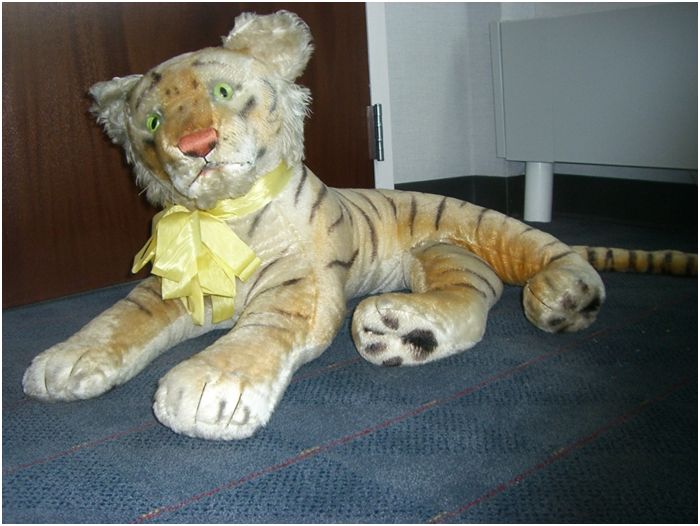 Quincy’s Current Home 2017 - ?
Quincy’s Current Home 2017 - ?
January 3 2017
